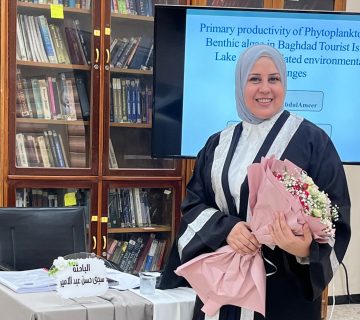Thesis Discussion
College of science for women/University of Baghdad examined the thesis entitled (Spectral Characterization of Laser-Induced Plasma of ZnO NPs: Green Synthesis of ZnO NPs using Chamomile Flower Extract and its Effect on the Skin using Textural Analysis) of the student .. Sarah Adel Abbas
- Spectroscopic study of Zn and chamomile flower
- Preparing ZnO NPs using two methods: physical (PLAL) and biological (green method using chamomile flower).
- Study the effect of prepared nanoparticles on healing superficial wounds using histological analysis.
dissertation also includes The plasma spectroscopy induced by Laser was studied for Zn and chamomile flowers. Zinc oxide nanoparticles were prepared using two methods: physical (pulsed laser ablation) and biological (green method using chamomile flower extract). The structural, morphological, optical, and chemical properties of the nanoparticles were studied using several tests XRD, UV-VIS, FE-SEM, AFM, EDX, FTIR, ZP, XRF. The synthesized nanoparticles were tested for their efficacy in healing superficial wounds.
The most important recommendations which the study has come up with and the average obtained.
- Expand biological studies: Conduct advanced clinical trials to evaluate the safety and efficacy of green-synthesised ZnO NPs for human wound healing.
- Optimise green synthesis conditions: Investigate the influence of parameters such as extract concentration, reaction time, and temperature to achieve higher purity and smaller particle sizes.
- Develop advanced medical applications by incorporating green-synthesised ZnO NPs into pharmaceutical products, such as topical ointments, innovative dressings, and wound-healing formulations.
- Explore antimicrobial potential: Assess the activity of the synthesized nanoparticles against a wide range of bacterial and fungal pathogens to validate their antimicrobial capabilities.
- Expand to other plant-based systems: Explore green synthesis using other medicinal plant extracts to discover alternative, eco-friendly routes with improved properties.
- Long-term safety assessment: Investigate possible cytotoxicity and long-term effects of chronic exposure to ensure complete biocompatibility.
The final grade: excellence










